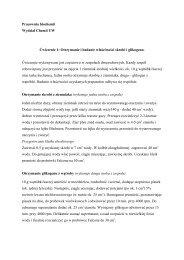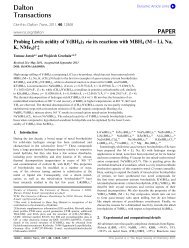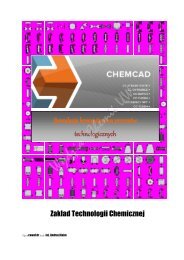Chem. Anal. (Warsaw), 53, 759
Chem. Anal. (Warsaw), 53, 759
Chem. Anal. (Warsaw), 53, 759
You also want an ePaper? Increase the reach of your titles
YUMPU automatically turns print PDFs into web optimized ePapers that Google loves.
772 Z. Hubicki, M. Wawrzkiewicz and A. Wo³owicz<br />
Figure 14. Structure of YPA 4<br />
The investigations performed by Chang et al. [39] on the applicability of epoxyimidazole<br />
resin (Fig. 15) to the sorption of trace quantities (20 ng cm –3 ) of Au(III),<br />
Pd(IV), Ru(III) ions from the solutions containing Cu(II), Mn(II), Zn(II), Ni(II), Pb(II),<br />
Cd(II), Hg(II), Ga(III), Cr(III), Bi(III) and Al(III) ions are of significant importance.<br />
Quantitative sorption of noble metal ions depended on pH and proceeded in the acidity<br />
ranges pH 2–6, pH 4–6, pH 4–7 for gold, palladium and rhodium ions, respectively.<br />
Ion exchange capacities equalled to 81.6 mg Au(III) g –1 , 64.7 mg Ru(III) g –1<br />
and 97.4 mg Pd(IV) g –1 resin. 96% desorption could be achieved with 6 mol L –1 HCl<br />
solution containing 0.2 g of thiourea. The sorbent with functional imidazole groups is<br />
characterized by fast sorption of Pd(II) ions [40].<br />
Figure 15. Epoxy-imidazole resin<br />
Parodi et al. [41] used imidazol resin for Pd(II) and Pt(IV) recovery from chloride<br />
solutions. The sorbent exhibited stronger affinity towards Pd(II) at low concentration,<br />
while Pt(IV) was preferably sorbed at higher HCl concentration. The metals<br />
loaded onto the resin were recovered using 0.1 mol L –1 thiourea solution. Desorption<br />
efficiency was 95% [41].<br />
The sorbent with benzimidazolylazo functional groups incorporated into the styrene–divinylbenzene<br />
matrix (Fig. 16) is recommended for selective sorption of Pd(II),<br />
Hg(II) and Ag(I) ions (0.62 mmol Pd(II) g –1 , 0.83 mmol Hg(II) g –1 and 1.00 mmol<br />
Ag(I) g –1 resin) from the solution of pH 4–6. 100% desorption of these ions from<br />
the bed is possible using acidic thiourea or concentrated HCl solutions. This sorbent<br />
has potential practical application in separation of Pd(II) ions from other noble metal<br />
ions since they do not sorb onto the resin, as well as in their recovery from dental







